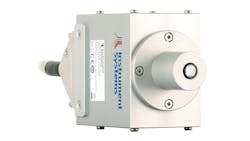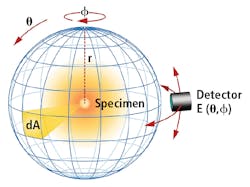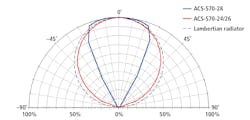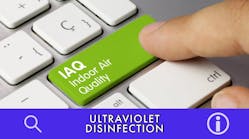UV LED sources demand calibration to precise measurements for safe operation (MAGAZINE)
Ultraviolet (UV) radiation covers a wide wavelength range between 100 and 400 nm and is divided into three main areas, according to ISO standard 21348 — UV-A, UV-B, and UV-C. Typical applications in the UV-A range between 315 and 400 nm are UV curing or UV ink printing. Light sources in the UV-B range between 280 and 315 nm are mainly used in medical skin treatment as phototherapies. The UV-C range between 100 and 280 nm can be applied in air and water disinfection, which is currently very relevant in the fight against pathogens such as the novel coronavirus SARS-CoV-2.
The lighting industry has seen increased demand for UV-C radiation sources since the COVID-19 pandemic originated. UV-C radiation between 255 and 265 nm has been studied as a highly efficient method of inactivating the DNA or RNA of microorganisms, e.g. coronavirus, and prevents their replication and ability to actively infect other cells. Investigational studies are ongoing, but some organizations have released promising data recently.
Due to their specific areas of application, all UV radiation sources should be characterized very precisely with regard to their radiant flux and spectral distribution. This requires particularly sensitive and reliable UV measuring equipment consisting of high-precision spectroradiometers with stray light correction, polytetrafluoroethylene (PTFE)-coated integrating spheres, and calibration standards for the UV wavelength ranges A/B/C. The most important function of UV LED calibration standards is the monitoring and characterization of UV integrating spheres for radiant flux. Thus far, established standards organizations such as Physikalisch-Technische Bundesanstalt (PTB; the national metrology institute of Germany) and the National Institute of Standards and Technology (NIST) have not offered such a reference standard for the UV-B and UV-C spectral regions.
As a result, Instrument Systems has undertaken studies to develop its own UV calibration standards, namely the Advanced Calibration Standards ACS-570-UV series (Fig. 1). These are temperature-stabilized UV-LED calibration standards that have a radiant flux calibration in the UV A/B/C range traceable to the national metrology institute. The traceability of the UV-ACS to the radiant flux has been achieved by precise calibration of the spectrometer coupling optics to the irradiance and by means of integrative measurement with a goniophotometer.
Calibration chain
For highly-precise spectral characterization and calibration, a defined calibration chain must be applied as illustrated in the top row of Fig. 2 (blue). National metrology institutes (NMIs) create the national standard of an SI unit — in this case, the definition of the candela or optical power. Regular comparison between the standards of each national institute enables a general quality check for global standards. The NMIs create calibrated reference standards for interested companies or institutes. With these reference standards, companies such as Instrument Systems create calibrated transfer standards, which are used to measure and characterize other light sources, the so-called working standards. These are then used for factory calibration of measurement systems.
The bottom row (red) in Fig. 2 shows the characterization chain at Instrument Systems. The NMI (e.g., PTB) provides Instrument Systems with a calibrated 1000W FEL halogen lamp, a deuterium (D2) lamp, and a UV LED. All standards are calibrated on irradiance E (W/m2) at specific distances. With the FEL and D2 lamp, a spectroradiometer and its connected optics are calibrated spectrally and absolute, and can then be defined as transfer standards.
Based on the transfer standard, other light sources (e.g., UV-ACS) can be characterized and set as new working standards. The third PTB calibrated irradiation standard (UV LED) is used as the control unit. This double-control system guarantees the highest precision to customers, who use the standards for their product quality control and characterization processes.
Considerations for precise measurements
Typically, multiple (working) standards at different wavelengths and broadness are offered. Most applied sources are visible-light sources for control measurements during fabrication. Infrared (IR) standards are also in demand. But currently, the focus lies on the characterization of UV LED standards with typical peak wavelengths of 280 nm (UV-C), 305 nm (UV-B), and 365 nm (UVA) (Fig. 3). For any kind of calibration, then characterization of light sources, the following requirements are essential to fulfill:
- Low wavelength drift
- Low power output drift
- Stable mechanical interface
- Robustness against environmental loads
Internal qualification tests — e.g., long-term optical characterization, thermal, humidity, and mechanical tests — are needed to guarantee the quality of the sources for multiple applications. Besides the light sources, metrology equipment and surroundings have to fulfill these requirements for accurate and reproducible results. For example, a UV-enhanced spectroradiometer is vital for exact spectral-power measurements in the UV range.
A stray-light correction is necessary to minimize any measurement uncertainty of the spectroradiometer. This can be created with a tunable optical source that emits narrow (<1 nm) spectral lines at different wavelengths. For the UV-enhanced spectroradiometer, the light source tunes the output wavelength between 210 nm and 850 nm stepwise, then the spectroradiometer measures it. Thus, multi-order or internal scattering light can be detected and numerically corrected.
Other equipment for precise measurement includes the optical coupling unit. A special diffusing element connected with UV-enhanced optical fiber bundles is used for UV applications. The diffusing element ensures homogeneity in detection and the fiber bundle enables flexible handling in combination with high power throughput. However, this unit is not characterized by radiant flux (W) but by irradiance (W/m2) since its measurement “spot” is defined by a diffusing element with limited dimension.
Realization of radiant flux in UV
A general approach uses an integrating sphere to measure the complete output power of the light and therefore the radiant flux in watts. Integrating spheres exist with barium sulfate (BaSO4) or PTFE as the internal reflection surface with high reflective index (>0.95). Unfortunately, both surfaces suffer in the UV region. The reflectivity index of BaSO4 lowers with shorter wavelength and lowers the throughput of the integrating sphere; PTFE has reflectivity indices above 0.9, but fluorescence will influence the throughput. Multiple efforts by many institutes and companies have been undertaken to minimize fluorescence with no enduring success.
Thus, another way must be found to create an overall power measurement of a UV LED. The presented solution is based on a goniophotometric spectral measurement. Using a goniophotometer, an imaginary sphere around the LED source can be created as shown in Fig. 4. The target (light source) is rotated stepwise in two rectangular angles: θ in (0, π) and φ in (-π/2, +π/2). The measurement system comprising the spectroradiometer and optics measures the irradiance at the specific angle and distance E(r0,φ,θ) in W/m2. The distance is known, and with the measured irradiances at each angle, the numerical integration results in the total output power of the light source. An additional advantage of the goniophotometric measurement is that angle emission of a light source can be characterized as well (Fig. 5).
Just to note, goniophotometric measurements take more time for each light source compared to an integrating sphere. Due to this fact, the long-term stability of the optical characteristic is implemented in the basic requirements of the light sources (<0.2% in 12 hr and <1% in 100 hr).
A major aspect of the reliability of this system is the control point at E(r0, φ=0, θ=0). Before the new UV LED is characterized, the PTB reference UV LED can be used as the control unit. Its irradiation value is exactly known at this point and any larger deviation would result in a false calibration of the transfer standard or in a failure of the goniophotometer setup. Thus, a double check with differently-calibrated standards is performed.
The total amount of uncertainty is calculated for the three peak wavelengths and results in the following measurement uncertainty values (k=2):
- UV-A (365 nm): 2.0%
- UV-B (305 nm): 3.5%
- UV-C (280 nm): 4.5%
Conclusion
The overall combination of multiple sources and control measurements with prior quality checks of measurement devices and stable light sources is necessary for multiple applications where standards are used. The characterization of the ACS UV standards as described here is a combination of multiple precise steps:
- All measurements are traceable to national standards
- The light source itself is manufactured with the highest demands on optical characteristics, mechanical tests, and thermal stability to ensure long-term duration of calibration
- Spectral measurement setups (UV spectrometer, optical coupling unit, and UV fibers) are selected and characterized with the aim of minimizing fluorescence and stray light influences
- The mechanical setup (goniometer) enables not only overall power characterization of the device under test but the angular characteristics as well
- Double confirmation with separate calibrated light sources (both with equipment traceable to national standards) delivers maximum reliability and minimum uncertainty
The extremely low measurement uncertainties (k=2) of the UV-ACS are comparably low to those in the metrologically unproblematic visible range, thereby offering a reliable resource for radiant flux calibration in the UV-A, UV-B, and UV-C ranges.
Get to know our experts
DR. BASTIAN EDER is project manager metrology and DR. ÐENAN KONJHODŽIĆ is project manager at test & measurement specialist Instrument Systems.
For up-to-the-minute LED and SSL updates, why not follow us on Twitter? You’ll find curated content and commentary, as well as information on industry events, webcasts, and surveys on our LinkedIn Company Page and our Facebook page.








![The DesignLights Consortium continues to make progress in shifting outdoor lighting products and implementation practices toward a more restrained and thoughtful strategy. [Image does not represent a DLC qualified fixture.] The DesignLights Consortium continues to make progress in shifting outdoor lighting products and implementation practices toward a more restrained and thoughtful strategy. [Image does not represent a DLC qualified fixture.]](https://img.ledsmagazine.com/files/base/ebm/leds/image/2024/08/66be810888ae93f656446f61-dreamstime_m_265700653.png?auto=format,compress&fit=&q=45&h=139&height=139&w=250&width=250)
